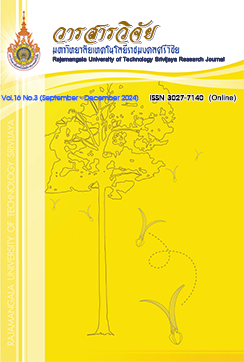Development and Acceptance of Time Attendance Web Application Using Identity Verification with Picture and Location of Personnel in Private Universities
Keywords:
acceptance, web application, time attendance, private universityAbstract
This research aims to develop a time attendance web application (TAW) by using identity verification with picture and location in private universities, as well as to study personnel’s acceptance of the TAW. The population consisted of the Head of the Human Resource department and 94 instructors in Phitsanulok University. Data were collected through in-depth interviews and questionnaires, and were statistically analyzed using content analysis, descriptive statistics, and comparable statistics. The developed web application took the form of a responsive web, accessible on both computer and portable devices which was developed with open-source web programing languages: PHP, Java script, and JQuery. It consisted of 3 main functions: identity verification through personnel pictures and geographical location for sign-in and sign-out work attendance points, work-in record, and monthly work attendance summary reports. Overall, the personnel showed a high level of satisfaction with the TAW (x̄=4.46, SD=0.68) and also accepted it at a high level (x̄=4.08, SD=0.63). Personnel of different sexes, ages, and position levels showed varying levels of acceptance of the TAW in both the internal and supplemented factors, with statistical significance at .05.
References
Bhrommalee, P. 2011. Student acceptance of webbased learning: A quantitative analysis within a public University in Thailand. Doctor of Philosophy (Applied Management and Decision Sciences, Walden University.
Chen, H.R. and Tseng, H.F. 2012. Factors that influence acceptance of web-based e-learning systems for the in-service education of junior high school teachers in Taiwan. Evaluation and program planning 35(3): 398-406.
Chigwada, J.P. 2022. Open-Source Software Use in Libraries in Developing Countries, p. 22. In Lamba, M., eds. Technological Advancements in Library Service Innovation. IGI Global, United States.
Human Resource Department. 2022. Interviewing Results About the Signing Problems and Requirements. Publish documents, Human resource department, Phitsanulok University.
Jiang, W., Zhang, M., Zhou, B., Jiang, Y. and Zhang, Y. 2014. Responsive web design mode and application, pp. 1303-1306. In 2014 IEEE Workshop on Advanced Research and Technology in Industry Applications (WARTIA). IEEE, Ottawa, Canada.
Kaufman, G. and Elder Jr, G.H. 2002. Revisiting age identity: A research note. Journal of Aging Studies 16(2): 169-176.
Moschis, G. 1992. Marketing to Older Consumers: A Handbook of Information for Strategy Development. Bloomsbury Academic, England.
Motaghian, H., Hassanzadeh, A. and Moghadam, D.K. 2013. Factors affecting university instructors' adoption of web-based learning systems: Case study of Iran. Computers & Education 61: 158-167.
Natasia, S.R., Wiranti, Y.T. and Parastika, A. 2022. Acceptance analysis of NUADU as e-learning platform using the Technology Acceptance Model (TAM) approach. Procedia Computer Science 197: 512-520.
Rungreangkulkij, S. and Kittirattanapaiboon, P. 2021. The impact of gender on mental health and concepts of gender approach mental health policy. Journal of Mental Health of Thailand 2021 29(3): 259-272. (in Thai)
Sánchez, R.A. and Hueros, A.D. 2010. Motivational factors that influence the acceptance of Moodle using TAM. Computers in Human Behavior 26(6): 1632-1640.
Sun, H.C., Liu, X.F., Xu, X.K. and Wu, Y. 2020. Analysis of COVID-19 spreading and prevention strategy in schools based on continuous infection model. Wuli Xuebao/Acta Physica Sinica 9(24): 1-23.
Wibirama, S., Santosa, P.I., Widyarani, P., Brilianto, N. and Hafidh, W. 2020. Physical discomfort and eye movements during arbitrary and optical flow-like motions in stereo 3d contents. Virtual Reality 24(1): 39-51.
Yusufu, S.O., Elizabeth, A.Q. and Abel, O.A. 2022. Information Communication Technology and The Performance of Selected Retail Business Outlets in Abuja Nigeria. Asian Journal of Management, Entrepreneurship and Social Science 2(1): 87-97.
Downloads
Published
How to Cite
Issue
Section
License
Copyright (c) 2024 Rajamangala University of Technology Srivijaya Research Journal

This work is licensed under a Creative Commons Attribution-NonCommercial-NoDerivatives 4.0 International License.
The content and information in the article published in Journal of Rajamangala University of Technology Srivijaya It is the opinion and responsibility of the author of the article. The editorial journals do not need to agree. Or share any responsibility.







